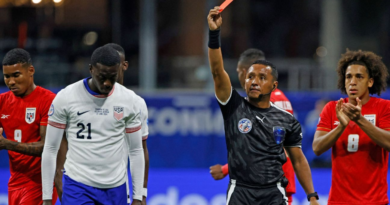Wonder about Wander and his teammates no more
Everybody loves a winner, and in saying “everybody,” by definition, yes, that includes us fantasy managers.
In case you haven’t heard, the Tampa Bay Rays entered play on Wednesday as winners of 11 straight games, tied for the second-longest streak to begin a season. The last time a team got off to this good a start, I was playing my simulation baseball league on the brand-new Earl Weaver Baseball while trying to polish off my complete set of wood-grained border Topps baseball cards. (But, for the record, I’m still 25 and stand by that.)
Fantasy managers have taken notice, as four individual Rays players have seen their roster percentages in ESPN leagues rise by 10% or more since Opening Day: Zach Eflin (+16.3%), Isaac Paredes (+15.7%), Jeffrey Springs (+12.9%) and Drew Rasmussen (+11.5%). That ties the team with the Baltimore Orioles for the most such players during that 13-day time span. The Rays now have eight players rostered in a majority of ESPN leagues, trailing only the Atlanta Braves, Houston Astros and Toronto Blue Jays (11), the Los Angeles Dodgers and New York Yankees (10) and the Cleveland Guardians, New York Mets and San Diego Padres (9).
Naysayers point out that the Rays have fattened up their win number by capitalizing upon an unusually easy schedule during the season’s opening days, and it’s fair to say that not one of the team’s first three opponents was expected by anyone to win even as many as 70 games (Detroit Tigers, Washington Nationals, Oakland Athletics). I remind you, however, that part of the mark of a good team is dominating the opponents you’re supposed to, and the Rays are certainly winning their games by a handy margin, outscoring those three teams by a combined 57 runs over their first nine games.
For our purposes, however, what is the proper evaluation of this scorching-hot team? The Rays have been very, very good, managing a .550 winning percentage or better in four of the past five seasons with the fourth-most wins in baseball since the beginning of 2008 (1,278 total wins or 88.5 per 162 games). Still, fantasy managers tend to be a bit hesitant to invest heavily in the Tampa Bay roster. For example, only three Rays were selected among the top 120 players overall in either ESPN points-based leagues or NFBC rotisserie leagues on average during the preseason: Shane McClanahan, Wander Franco and Randy Arozarena.
The reason, presumably, is the Rays’ role-driven approach, which presents a fair argument against trusting their players as single-handed fantasy title winners.
On the pitching side, consider that only six Rays pitchers have even qualified for the league’s ERA title (requiring a minimum of one inning per team game, or 162 IP for a “normal” full season) over the last six years, with five of those hurlers having since moved on to other teams. Only 19 Rays have managed even 100 innings during that time span. By comparison, only the Los Angeles Angels, Miami Marlins and Athletics had fewer 100-inning pitchers — and all of them had significantly worse team ERAs in that time than did the third-ranking Rays (3.69).
Still, there’s a lot of fantasy profit potential in this Rays pitching staff, for multiple reasons. First off, this team is structured around pitchers who are generally up-and-comers, who were using the 2021-22 campaigns as effective stepladder-style workload build-ups. McClanahan, Rasmussen and Springs each amassed at least 43 more innings last season, the group averaging a 67 2/3 inning boost, than in 2021. ESPN’s projections — not to mention most of the publicly available systems — had each enjoying more than a 10-IP increase in 2023 compared to 2022. There’s a good chance that all three are headed towards personal bests in innings pitched.
Second, all three pitchers serve as illustrations of what the Rays do best, being creative while coaxing the most out of their players. McClanahan and Rasmussen have both added a hint of velocity to their fastballs this season, Rasmussen continues to polish the cutter and sweeper that he added to his repertoire in 2021-22, and Springs has added more depth to his slider, now frequently classified as a sweeper, this year. In addition to their workload boosts, their skill-set arrows are pointing upward.
Finally, the advantage that the matchups-conscious Rays grant is a far lesser likelihood of fantasy team-damaging, poor pitching outings. Consider that in 2022, only 24 times did a Rays starter finish with a negative fantasy point total, fourth-fewest behind only the Dodgers (16), Astros (17) and Yankees (19). It wasn’t a one-year thing, either, as their 26 such games in 2021 were fifth-fewest. Plus, as far as positive, useful outings are concerned, Rays starters scored between 5-20 fantasy points on 167 occasions from 2021-22, tied with the Seattle Mariners for the most in MLB.
Focusing on their hitters next, while the Rays love to exploit daily matchups, using 10 different lineups through 10 games thus far (after 158 different lineups in both 2021 and 2022 and 59 different ones over the 60 games of 2020), that’s actually more beneficial than you might realize due to the construct of ESPN’s standard league settings. Extracting only starting assignments last season, four different Rays finished with a greater than 2.30 fantasy points per game average — Yandy Diaz, Franco, Paredes and Arozarena — making them one of only seven teams that can claim at least that many such hitters.
So here’s the 2023 Rays fantasy baseball accounting, thus far, to further illustrate their value: Four hitters place among the top 21 in fantasy points (Franco, Arozarena, Brandon Lowe and Diaz). Three pitchers place among the top nine in fantasy points (Springs, Rasmussen and McClanahan). Six, meanwhile, place among the top-26 overall on the Player Rater (Franco, Rasmussen, Springs, Arozarena, McClanahan, Brandon Lowe).
Put it all together, and the Rays are the perfect fit for success in ESPN’s standard, daily lineups offering. Checking their roster percentages, in fact, this team is probably being undervalued. Take a closer look at these players in particular:
 Brandon Lowe (80.7% rostered): One of the best power sources from the 2B position, Lowe has had a 90th-percentile-or-better Statcast Barrel rate in three of the past four years. He’s typically a No. 2 hitter against right-handed pitchers, maximizing his plate appearances in those games.
Brandon Lowe (80.7% rostered): One of the best power sources from the 2B position, Lowe has had a 90th-percentile-or-better Statcast Barrel rate in three of the past four years. He’s typically a No. 2 hitter against right-handed pitchers, maximizing his plate appearances in those games.
 Diaz (79.4% rostered): One of the more underrated points-based and OBP league-specific hitters, Diaz is the only player in baseball with at least 500 plate appearances, a sub-15% strikeout rate and a sub-20% chase rate (percentage of swings at non-strikes) with at least a .280 Statcast expected batting average. He has made all nine of his starts thus far at leadoff, helping him to, like Lowe, maximize his trips to the plate.
Diaz (79.4% rostered): One of the more underrated points-based and OBP league-specific hitters, Diaz is the only player in baseball with at least 500 plate appearances, a sub-15% strikeout rate and a sub-20% chase rate (percentage of swings at non-strikes) with at least a .280 Statcast expected batting average. He has made all nine of his starts thus far at leadoff, helping him to, like Lowe, maximize his trips to the plate.
 Josh Lowe (2.3% rostered): A one-time popular fantasy prospect, Lowe struggled mightily as a rookie in 2022 but had a strong spring (.250/.313/.500 with three homers and three steals) and is showing much-improved contact. He’s the post-hype sleeper that is worthy of a stash in larger leagues, and since he seems to be moving into a No. 6-7 lineup role against right-handers, he’s pretty close to being of use in daily mixed leagues as well.
Josh Lowe (2.3% rostered): A one-time popular fantasy prospect, Lowe struggled mightily as a rookie in 2022 but had a strong spring (.250/.313/.500 with three homers and three steals) and is showing much-improved contact. He’s the post-hype sleeper that is worthy of a stash in larger leagues, and since he seems to be moving into a No. 6-7 lineup role against right-handers, he’s pretty close to being of use in daily mixed leagues as well.
 Pete Fairbanks (29.4% rostered): The only reason he’s not rostered in more leagues is the Rays’ tendency to “mix and match” in the ninth inning. Nevertheless, Fairbanks’ skills are the most closer-like of any of their relief pitchers and with our game now rewarding two points per hold to go along with five-point saves, the right-hander’s value gets a settings-driven boost in 2023. He hasn’t been much of a factor yet since the Rays have been winning their games handily, but their upcoming schedule leans tougher, presumably pressing him into a greater amount of late-inning duty.
Pete Fairbanks (29.4% rostered): The only reason he’s not rostered in more leagues is the Rays’ tendency to “mix and match” in the ninth inning. Nevertheless, Fairbanks’ skills are the most closer-like of any of their relief pitchers and with our game now rewarding two points per hold to go along with five-point saves, the right-hander’s value gets a settings-driven boost in 2023. He hasn’t been much of a factor yet since the Rays have been winning their games handily, but their upcoming schedule leans tougher, presumably pressing him into a greater amount of late-inning duty.
 Eflin (23.3% rostered): Although he is currently on the IL due to back tightness, Eflin’s strong first two outings of 2023 shouldn’t be forgotten merely because he’s unavailable today. His improving control and heightened use of his curveball has made him a more reliable fantasy option in Tampa Bay than he ever was in seven seasons in Philadelphia, so even if you can’t stash him right now, be prepared to add him immediately when he returns sometime in the next few weeks.
Eflin (23.3% rostered): Although he is currently on the IL due to back tightness, Eflin’s strong first two outings of 2023 shouldn’t be forgotten merely because he’s unavailable today. His improving control and heightened use of his curveball has made him a more reliable fantasy option in Tampa Bay than he ever was in seven seasons in Philadelphia, so even if you can’t stash him right now, be prepared to add him immediately when he returns sometime in the next few weeks.




